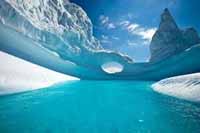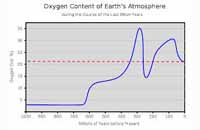


 A recent study by NASA (Goddard Space Flight Center in Greenbelt, Maryland, USA) based on analysis of satellite data has confirmed that there is a net gain of Ice Cover at Antarctica every year from 1992 onwards. An increase in Antarctic snow accumulation that began 10,000 years ago is currently adding enough ice to the continent to outweigh the increased losses from its thinning glaciers. A recent study by NASA (Goddard Space Flight Center in Greenbelt, Maryland, USA) based on analysis of satellite data has confirmed that there is a net gain of Ice Cover at Antarctica every year from 1992 onwards. An increase in Antarctic snow accumulation that began 10,000 years ago is currently adding enough ice to the continent to outweigh the increased losses from its thinning glaciers.The NASA Study findings are in contradiction to Intergovernmental Panel on Climate Change’s (IPCC) 2013 report which says that Antarctica is overall losing land ice. According the report released, Antarctic ice sheet showed a net gain of 112 billion tonnes of ice a year from 1992 to 2001 and 82 billion tonnes of ice per year between 2003 and 2008. The discharge of Ice in the Antarctic peninsula and the Thwaites and Pine Island region of West Antarctica is more but East Antarctica and the interior of West Antarctica are stated to be gaining more ice that exceeds the losses in the other areas. |
Rajeev Gupta |

 Oxygen currently accounts for about 21% of the Gases in the Earth Atmosphere. This, level has not been constant in the history of the planet. It is believed that for the first couple of billion years, there was little oxygen in the atmosphere and about 2.5 billion years ago, oxygen started getting added to the atmosphere by photosynthetic cyanobacteria. Oxygen currently accounts for about 21% of the Gases in the Earth Atmosphere. This, level has not been constant in the history of the planet. It is believed that for the first couple of billion years, there was little oxygen in the atmosphere and about 2.5 billion years ago, oxygen started getting added to the atmosphere by photosynthetic cyanobacteria.As we know, Oxygen is produced as a waste product of photosynthesis. It is consumed through respiration. In old times, this waste product sparked a mass extinction known as the Great Oxygenation Event, but new forms of life evolved using oxygen in respiration, and after that atmospheric oxygen levels have continued to be increasing. Atmospheric oxygen levels have varied from a low of 10 percent to a high of 35 percent over the last 540 million years, as per the study carried out at the University of Michigan. Oxygen levels are dropping now, but at a very slow rate, approximately tens of parts per million per year. This rate is much too slow to affect climate in the modern world. |
Pooja Sharma |

 Tsunami (a Japanese name. pronounced as Sunami) denotes series of large ocean waves typically caused by large undersea earthquakes at tectonic plate boundaries. Tsunami waves send surges of water, sometimes reaching
heights of over 100 feet (30.5 meters), onto land. These walls of water can cause widespread destruction (loss of lives and property) when they crash ashore. Tsunami (a Japanese name. pronounced as Sunami) denotes series of large ocean waves typically caused by large undersea earthquakes at tectonic plate boundaries. Tsunami waves send surges of water, sometimes reaching
heights of over 100 feet (30.5 meters), onto land. These walls of water can cause widespread destruction (loss of lives and property) when they crash ashore.Most tsunamis, about 80 percent, happen within the Pacific Ocean’s “Ring of Fire,” a geologically active area where tectonic shifts make volcanoes and earthquakes common. When the ocean floor at a plate boundary rises or falls suddenly it displaces the water above it and launches the rolling waves that will become a tsunami. A tsunami is usually composed of a series of waves, called a wave train, so its destructive force may be compounded as successive waves reach shore. The best defense against any tsunami is early warning that allows people to seek higher ground. The Pacific Tsunami Warning System, a coalition of 26 nations headquartered in Hawaii, maintains a web of seismic equipment and water level gauges to identify tsunamis at sea. Similar systems are proposed to protect coastal areas worldwide. |
Pooja Sharma |
 Bridgmanite makes up about 70 percent of the earth’s lower mantle and 38
percent of the total volume of the earth. It is made up of high-density
magnesium iron silicate. The lower mantle, which starts at 670 km under the crust, is difficult to access for samples. Bridgmanite makes up about 70 percent of the earth’s lower mantle and 38
percent of the total volume of the earth. It is made up of high-density
magnesium iron silicate. The lower mantle, which starts at 670 km under the crust, is difficult to access for samples. The researchers looked at a meteorite that had fallen inside Australia in 1879 as a likely candidate for samples, and found what they were looking for. Under the rules of set down by the International Mineralogical Association, a mineral cannot be given a formal name until a specimen has been found and examined first hand. The new name is in honour of Percy Bridgman, a pioneer in the use of high pressure experiments to better understand how many geological formations come about. |
Raginee |
 On this day Shri Narendra Modi Ji has assumed office as Prime Minister of India. He has won hearts of majority of Indians and given a hope of leading the country in a better way. His actions in last a few months have given a clear indication that future is in safe hands and the country will progress faster. On this day Shri Narendra Modi Ji has assumed office as Prime Minister of India. He has won hearts of majority of Indians and given a hope of leading the country in a better way. His actions in last a few months have given a clear indication that future is in safe hands and the country will progress faster. |
M. Manohar |

 The great Himalaya Range us the longest snow-capped mountain range in the world. It runs for around 2300 Kilometers along the northern parts of India. The average height if the range is 6100 Meters, and it contains some of tallest peaks, including Mount Everest, Nanga Parvat, Kanchenjunga and Annapurna. 19 Rivers originate from Himalaya providing essential water and soil resources for agriculture. The high mountains obstruct the passage of chilling air from the north hemisphere into India in winter, and also force the rain-bearing winds of South-West monsoon to give most rains before crossing Himalaya. The Great Himalaya contain valuable forests of spruce, fir, cypress, juniper and birch. The great Himalaya Range us the longest snow-capped mountain range in the world. It runs for around 2300 Kilometers along the northern parts of India. The average height if the range is 6100 Meters, and it contains some of tallest peaks, including Mount Everest, Nanga Parvat, Kanchenjunga and Annapurna. 19 Rivers originate from Himalaya providing essential water and soil resources for agriculture. The high mountains obstruct the passage of chilling air from the north hemisphere into India in winter, and also force the rain-bearing winds of South-West monsoon to give most rains before crossing Himalaya. The Great Himalaya contain valuable forests of spruce, fir, cypress, juniper and birch. |
Pooja Sharma |
 Temperature records were shattered across the United States of America on Tuesday as the polar vortex continued to take hold, with all 50 states experiencing freezing temperatures at some point in the day. Temperature records were shattered across the United States of America on Tuesday as the polar vortex continued to take hold, with all 50 states experiencing freezing temperatures at some point in the day.A polar vortex also known as a polar cyclone, is a persistent, large-scale cyclone located near either of a planet's geographical poles. On Earth, the polar vortices are located in the middle and upper troposphere and the stratosphere. They surround the polar highs and lie in the wake of the polar front. These cold-core low-pressure areas strengthen in the winter and weaken in the summer due to their reliance upon the temperature differential between the equator and the poles. This year, it is unusual when polar vortex has caused sub zero temperatures across almost all states of United States of America. |
Swati Arora |
 Gurgaon has emerged as the most prosperous city in India as per findings of CRISIL, a credit rating agency. Gurgaon gets the leading position based on ownership of consumer durables as a measure of prosperity, leaving behind many cities. 27% of households in Gurgaon own all gadgets, ahead pof Chennai with 24%, Bangalore with 23.6% and Mumbai at 15.7%. Gurgaon has emerged as the most prosperous city in India as per findings of CRISIL, a credit rating agency. Gurgaon gets the leading position based on ownership of consumer durables as a measure of prosperity, leaving behind many cities. 27% of households in Gurgaon own all gadgets, ahead pof Chennai with 24%, Bangalore with 23.6% and Mumbai at 15.7%. |
Pooja Sharma |